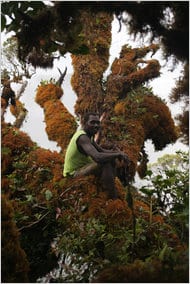
Kolombangara white-eyes. Photo by Andrew Cox
Tuesday, Oct. 12
After 12 hours of walking, climbing and crawling through tangles of huge roots, fern trees and bamboo, our full team has reached and settled into our high camp. We are perched in a small cleft at 1,600 meters elevation on the flanks of Veve, the highest point on Kolombangara. Moving about here is like balancing in the canopy of a huge moss-covered tree, the ground one or two meters beneath a lattice of roots and prostrate trunks of trees that twist up, stunted, into the mist that drips incessantly.

Pitching a tent is almost laughable, and I struggle not to slip down my damp tent floor as I write. Yet thanks to our Kolombangara guides, we do have fire, hot tea and rice, and bamboo abounds for drinking and cooking water. Once we had warmed and nourished ourselves a bit — though 85 humid degrees in the lowlands, temperatures here now wavered in the mid-50s with wind and spitting mist — we set to work.
Two longtime collaborators of mine are leading much of the research on this expedition: an outstanding botanist, Myknee Sirikolo, and an exceptional herpetologist, Patrick Pikacha (who moonlights as a photographer and author). The research agenda of our trip here is twofold: first, to better document the biology and patterns of endemism in the poorly known cloud forests of the Solomons, and, second, to collect specimen and behavioral data on endemic birds, frogs and mammals for inclusion in our ongoing studies of the origins and evolution of island life.
To achieve our research goals, we are like acrobats — well, our guides are like acrobats — setting mammal traps, stringing “mist” nets along the ridgelines to capture birds and bats from the air like gill-netting fish in the sea, and marking trails through prime frog habitat that can be followed in the black, cloud-enshrouded nights when these amphibians are active. All the while our crack botanist, Myknee, with encyclopedic knowledge of the flora here, is describing plant communities across altitudes we traverse and collecting specimens of species unknown to him.

Undescribed species abound here. Many of the plants unknown to Myknee will be unknown to science. Little recent work has been done on Solomon frogs, particularly in the uplands, so most or all of the species encountered could be new to science. Even within relatively well-described vertebrates like birds and mammals, we know little of species habits and distributions. Here in the heights of Kolombangara, these gaping holes in the fabric of basic biological knowledge have impeded both understanding of evolutionary origins and work to conserve its processes and products.
But already, even after just one cloud-enshrouded day, our work here is revealing some of Kolombangara’s biological secrets. Ghostly pale mountain-pigeons are abundant along the ridgelines. They are found only in the montane forests of the Solomons, and little is known of their habits. We have found several active nests and documented molt — the annual replacement of worn feathers — in nearly all individuals observed. This coincides with observations of molt in nearly all of the birds we have observed or captured thus far. Molt in the lowlands is asynchronous for most species, as is breeding. These initial results suggest that cloud forest bird communities may have far more seasonal life histories compared with relatively aseasonal annual cycles in lowland birds.

Within the first several hours of netting, we capture a whole flock of endemic Kolombangara white-eyes, one of our target species, which are found only on Kolombangara above 800 meters. Past molecular work by my wife and me has revealed that the low elevation white-eye inhabiting the forests far below us is not the Kolombangara white-eye’s near relative, as once believed. The bird we captured today is a more recent arrival closely related to white-eyes in distant New Guinea. It is our hope that increased genetic sampling (from specimen and blood collection in the field), in combination with our foraging and behavioral observations, will reveal why this endemic montane white-eye was able to speciate in such close geographic proximity to the lowland species.
Through it all, this place feels fresh and unexplored, and there is a wonder to being in this biologist’s daydream. Yet there is another deeper history. On our trek up from Imbu Rano, we passed countless stone artifacts and altars, “tambu,” or sacred places, places of past sacrifice and communion with spirit worlds. And rising out of the trail, there was a massive ancient stone map with a full-relief depiction of montane Kolombangara. Prior to European contact, these were known places to Kolombangara people, complete with sculptured maps of the thoroughfares and hidden places. What is discovery for science is also an exploration of natural rhythms that spawned the first naming of what we now seek to name again — frogs, trees, birds — the sounds in the night as the drip quiets enough for us to hear the faint double chirp of a tiny frog yet to be renamed.
To learn more about Dr. Filardi’s research, take a look at this video produced by the National Science Foundation:

Evolutionary biologist Chris Filardi talks about his research on birds in the Solomon Islands, and his contributions to answering “Darwin’s great unanswered question.” Filardi is director of Pacific programs at the American Museum of Natural History’s Center for Biodiversity and Conservation.
Credit: Lisa Raffensperger and Jeremy Polk, National Science Foundation
